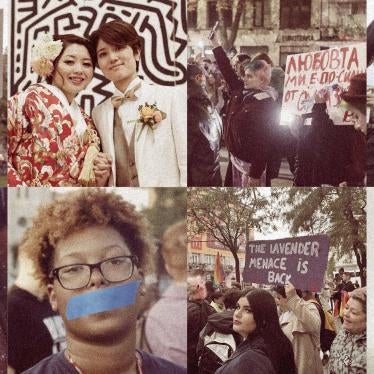Human Rights Watch wrote to Illinois Governor Pat Quinn to express support for his proposal to close the Tamms Correctional Center. We also sent similar letters to Illinois state legislators on the relevant appropriations committees and the Commission on Government Forecasting and Accountability. The text of the letter to Governor Quinn is below.
The Honorable Pat Quinn
Governor of the State of Illinois
Office of the Governor
207 State House
Springfield, IL 62706
Dear Governor Quinn:
We write in support of your proposal to close the Tamms Correctional Center. Supermaximum security confinement such as provided at Tamms is not only expensive, it is unnecessary and inhumane. States like Mississippi and Ohio have shown that substantial reductions to their supermax populations have improved the treatment of their inmates, saved money, and have not diminished prison safety and security.[1] As you stated in your 2013 budget address, “In times like these, we must be accountable and responsible.”[2] Closing Tamms is a step in that direction.
Human Rights Watch has written to you in the past to urge improvement in conditions at Tamms, which fail to respect the basic human rights of the men confined there.[3] These conditions are blatantly inconsistent with the state’s obligation under the International Covenant on Civil and Political Rights to ensure that conditions of confinement respect the inherent dignity and humanity of all prisoners and do not constitute torture or cruel, inhuman, or degrading treatment or punishment.[4]
Prisoners at Tamms have been held in prolonged solitary confinement for many years, some for more than a decade. They have been confined to their cells for 23 hours a day, with almost no chance for meaningful human interaction. The opportunity for physical exercise is minimal. There is little to see, less to do. Visual stimulus is purposely reduced. The extremes oftheisolation enforced at Tamms deprive the prisoner of much of what it means to be human. No state should have the ability to take away the core dignity of a human being, outside or inside a prison. Prison safety and security do not require the imposition of such conditions for prolonged periods of time.
Furthermore, the practice of holding inmates in solitary confinement for months and years on end violates the United States’ obligation under the Convention against Torture to bar any cruel, inhuman, or degrading treatment.[5] Juan Mendez, the United Nations Special Rapporteur on Torture, defines solitary confinement as “the physical and social isolation of individuals who are confined to their cells for 22 to 24 hours a day.”[6] Special Rapporteur Mendez expressed particular concern about “prolonged” solitary confinement, calling it cruel, inhuman, and degrading treatment (and in certain circumstances, outright torture) and recommending a ban on the practice.[7]
No prison in the US should be allowed to abuse its inmates, whether physically or, as in the case at Tamms, mentally. Prolonged solitary confinement can be psychologically harmful, provoking anxiety, depression, anger, cognitive disturbances, perceptual distortions, obsessive thoughts, paranoia, and psychosis.[8] It is particularly dangerous for those inmates, like many at Tamms, who already have serious mental illnesses. The conditions do not permit appropriate mental health treatment and, by their very nature, can aggravate the illness.
While closing Tamms is a step in the right direction, it is important that the inmates are not simply placed in similar conditions in other facilities. Experience in other states indicates that over-classification is common in supermax facilities; many of the inmates subjected to supermaximum security can in fact be confined at lower levels of security without jeopardizing prison safety. Shutting down Tamms provides an important opportunity to individually review the cases of every person there to determine the appropriate level of security.
For those at Tamms who are mentally ill, it is imperative that the mental health treatment they require is identified and that they are moved to a facility that can provide it. We recognize that mental illness can make it difficult for some inmates to conform their behavior to prison rules. But we urge you to ensure that they are not subjected to solitary confinement as a way to manage their conduct. Numerous court decisions and settlements have recognized that solitary is a toxic environment for the mentally ill and they should not—and need not—be subjected to it.
Finally, we urge you to use your authority to ensure that prolonged solitary confinement is not used in any of your correctional facilities. Conditions of confinement should be no more severe than necessary and should not violate the inherent human dignity of the prisoner. Ending the use of supermaximum security confinement will attest to Illinois’ commitment to sound correctional principles, common sense, fiscal prudence, and human rights. We hope state legislators see the wisdom of your decision, and we will be urging them to support it.
Sincerely,
Alison Parker
Director, US Program
Human Rights Watch
[1] Angela Browne, Alissa Cambier, Suzanne Agha, “Prisons Within Prisons: The Use of Segregation in the United States,” Federal Sentencing Reporter, Vol. 24, No. 1 (October 2011), p. 204.
[2] Governor Pat Quinn, Fiscal Year 2013 Budget Address, February 22, 2012, http://www2.illinois.gov/budget/Documents/Budget%20Book/FY%202013/FINAL%... (accessed March 2, 2012).
[3] Letter from Human Rights Watch to Governor Pat Quinn, May 4, 2009, https://www.hrw.org/news/2009/05/04/letter-illinois-governor-pat-quinn-re... Letter from Human Rights Watch to Governor Pat Quinn, September 8, 2009, https://www.hrw.org/news/2009/09/08/letter-il-governor-quinn-tamms-correc....
[4] International Covenant on Civil and Political Rights (ICCPR), adopted December 16, 1966, G.A. Res. 2200A (XXI), 21 U.N. GAOR Supp. (No. 16) at 52, U.N. Doc. A/6316 (1966), 999 U.N.T.S. 171, entered into force March 23, 1976, ratified by the United States on June 8, 1992.
[5] Convention against Torture and Other Cruel, Inhuman or Degrading Treatment or Punishment (Convention against Torture), adopted December 10, 1984, G.A. res. 39/46, annex, 39 U.N. GAOR Supp. (No. 51) at 197, U.N. Doc. A/39/51 (1984), entered into force June 26, 1987, ratified by the United States on October 21, 1994.
[6] UN General Assembly, Interim Report of the Special Rapporteur on torture and other cruel, inhuman or degrading treatment or punishment, Juan Mendez, A/66/268, August 5, 2011, http://daccess-dds-ny.un.org/doc/UNDOC/GEN/N11/445/70/PDF/N1144570.pdf?O... (accessed March 2, 2012), p. 9.
[7] Ibid., p. 2.
[8] Ibid., p. 18.






